You are here
- Home
- Publications and reports
- Data insights
- Sales workers: skills opportunities and challenges (2023 update)
Sales workers: skills opportunities and challenges (2023 update)
Summary
The retail industry is an important contributor in the European economy. In 2021, it accounted for more than 11 per cent of gross value added in the EU economy. Sales workers, who are mainly employed in the wholesale and retail trade sector, are one among the largest occupational groups in the EU.
Sales workers form the core of the wholesale and retail trade sector’s workforce. They fulfil various roles in the sector such as selling and demonstrating goods in shops, at stalls and markets, via telephone or other means. Jobs within this group include market and street food vendors, shop supervisors, sales assistants, cashiers, fashion models, and food service workers.
Key facts
- Around 13.7 million people were employed as sales workers in 2022, which accounts for almost 7 per cent of total EU employment in that year.
- Between 2012 and 2022 overall employment decreased slightly. Over the same period, employment across all occupations in the EU increased by almost 8 per cent.
- Between 2019 and 2020, when the EU experienced economic lockdowns, 928 thousand sales worker jobs were lost. By the end of 2022, employment had partly recovered and was 356 thousand workers short of the pre-Covid-19 level.
- Most sales workers – 81 per cent in 2021 - are employed in the wholesale and retail trade sector.
- Nearly two thirds of sales workers (62 per cent) have attained a qualification level of ISCED 3 and 4 in 2021, equivalent to upper secondary education/ post-secondary non-tertiary education . The qualification level of the occupation is not expected to change over the period to 2035.
- Sales workers are mainly women (around 65 per cent in 2021).
- The employment of sales workers is projected to remain almost stable between 2022 and 2035.
- By 2035, employment in the occupation is projected to decline by less than 5 per cent. Although there will be a fall in the overall number of people as sales workers, there will be a large number of sales workers' jobs to be filled over the same period. This is because an estimated 6.8 million people are expected to leave the occupation mainly due to retirement. This means that accounting for future job loss, over 6 million job openings will need to be filled between 2022 and 2035,
- Changes in customers’ preferences towards more personalized sales experiences and sustainable products and the introduction of digital technologies for analyzing customer needs and experiences and for assisting with store management will drive changes in sales workers’ skills required in the future.
Employment and job demand
Employment trends for sales workers were similar to all service and sales workers in the past decade. Larger employment drops, such as the one during the Covid-19 pandemic, were compensated by faster recovery in the growth years.
Figure 1: Year-to-year employment change for sales workers (2013-2022)
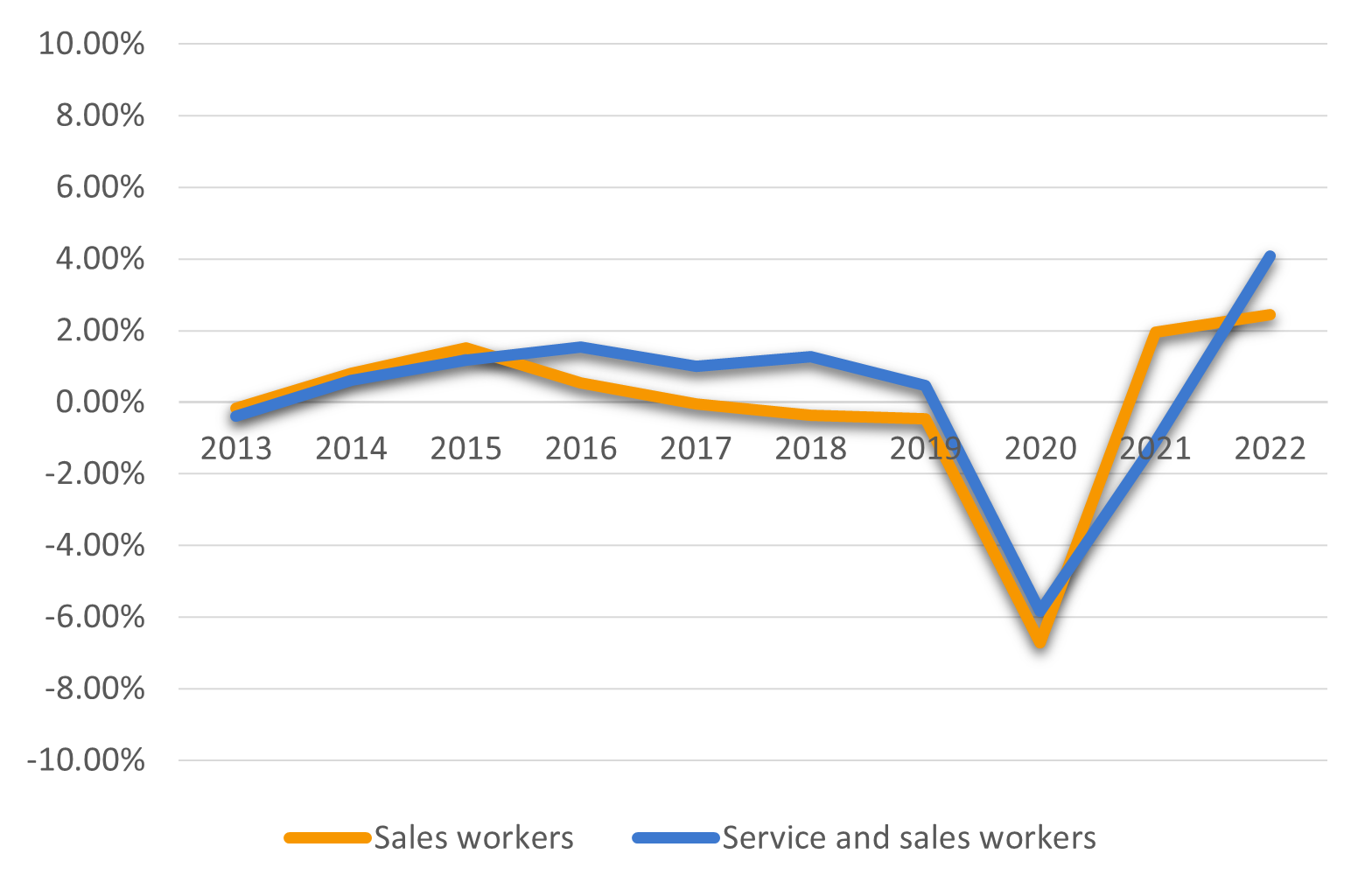 Source: European Labour Force Survey. Employed persons by detailed occupation (ISCO-08 two digit level) [LFSA_EGAI2D__custom_7778289]. Own calculations.
Source: European Labour Force Survey. Employed persons by detailed occupation (ISCO-08 two digit level) [LFSA_EGAI2D__custom_7778289]. Own calculations.
The majority of sales workers (74 per cent) are engaged as shop salespersons. People employed in these jobs conduct sales for wholesale and retail enterprises through physical shops. They acquaint customers with the goods or services to be sold and supervise the activities of shop sales assistants and cashiers.
About 10 per cent of sales workers are engaged as other sales workers. These include jobs such as art and fashion models, promotion demonstrators, door-to-door sellers, food service workers, and call centre agents.
In total, 9 per cent of sales workers are engaged as cashiers and ticket clerks, who work in wholesale and retail stores, restaurants and ticket offices and handle equipment, such as cash registers, optical price scanners, and computers that are used in selling goods and services. A small share of sales workers are engaged as street and market salespersons. These are workers who sell goods from stalls on markets or on streets and prepare and sell hot or cold foods and beverages ready for immediate consumption in streets and public places. They arrange for a regular supply of the products to be sold, keep a record of sales made and stock levels, and prepare food and drinks for sale. Over time the share of employment accounted for by these four occupations has remained more or less stable.
Figure 2: Employment in sales worker jobs (in %)
 Source: European Labour Force Survey. Microdata. Own calculations.
Source: European Labour Force Survey. Microdata. Own calculations.
Workers assisting people in making their purchases account for more than half of OJAs in the sales workers occupation group. The share of other sales workers and cashiers and ticket clerks is much higher in OJAs than in actual employment. As these occupations have not grown in employment significantly in past years, this could be attributed to higher job turnover, forcing employers to post vacancies more frequently.
For more details on skills demand and job openings for this occupation, please access the Cedefop’s Skills OVATE tool.
Figure 3: Online job advertisements for sales workers (2022, in %)
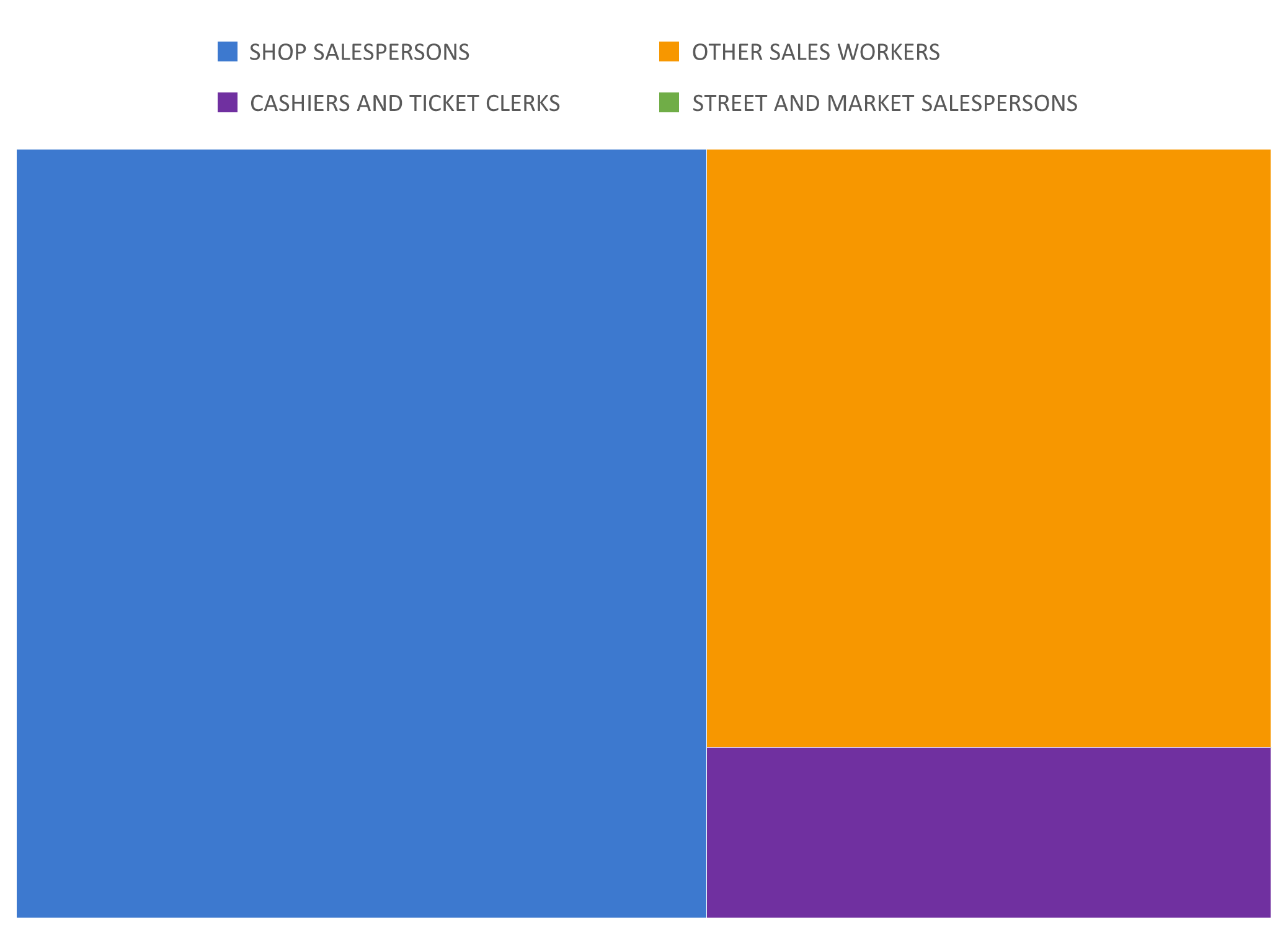 Source: Skills in Online Job Advertisements indicator based on Cedefop’s Skills OVATE. Own calculations. Note: Online job advertisements are by definition not equivalent to job vacancies. See Beręsewicz (2021) or Napierala et al. (2022).
Source: Skills in Online Job Advertisements indicator based on Cedefop’s Skills OVATE. Own calculations. Note: Online job advertisements are by definition not equivalent to job vacancies. See Beręsewicz (2021) or Napierala et al. (2022).
The Wholesale and retail trade sector employs the majority of sales workers - over 80 per cent in 2021 (see Figure 4). The accommodation and food service activities sector is nowadays the only other sector with a notable share of sales workers. In 2016 it accounted for only 4 per cent of sales worker employment, but this share had doubled to 8 per cent by 2021.
Figure 4: The top sectors employing sales workers (in %)
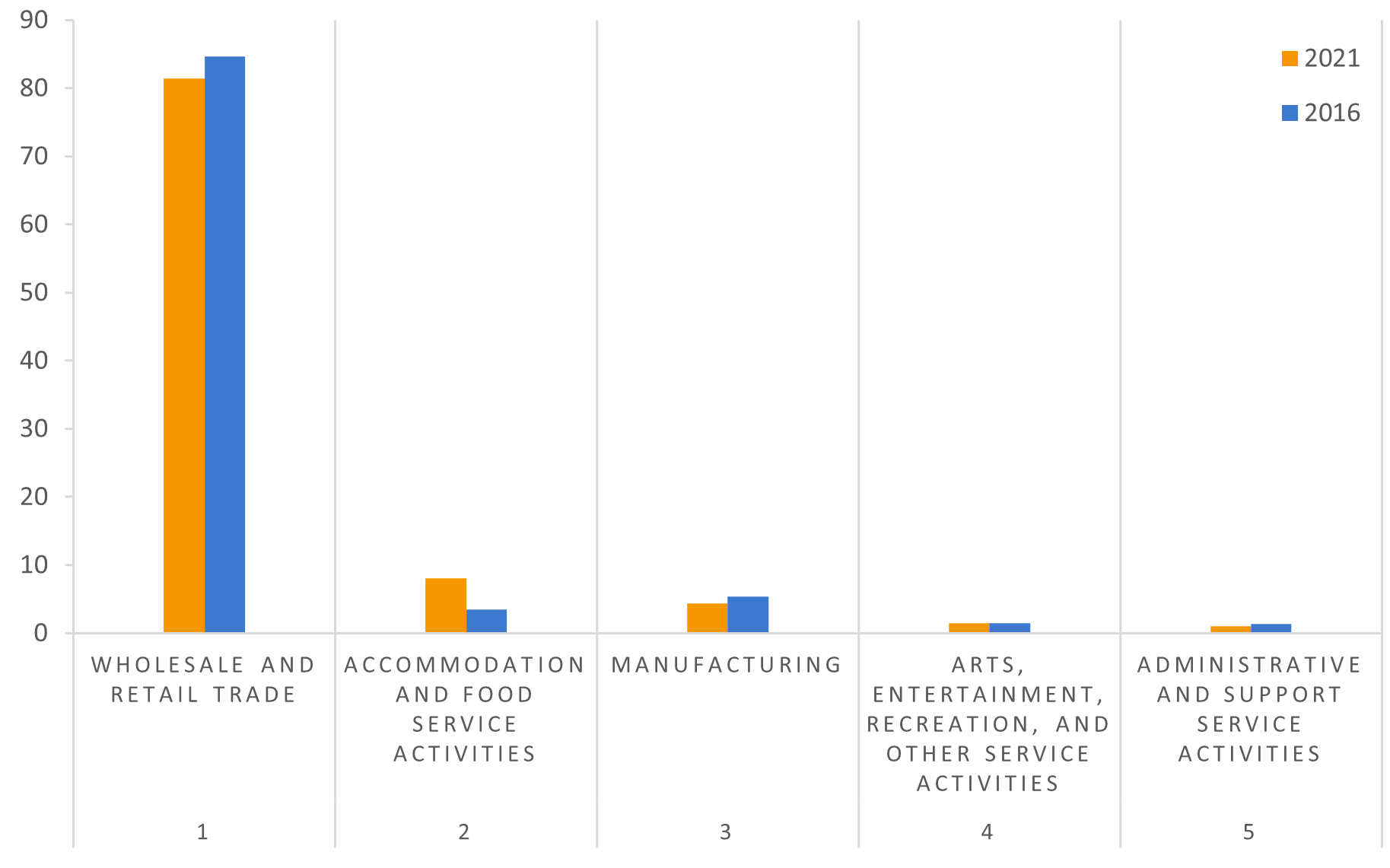 Source: European Labour Force Survey. Microdata. Own calculations.
Source: European Labour Force Survey. Microdata. Own calculations.
As regards the share of sales workers within sectoral employment, these workers form a significant portion of the workforce in the wholesale and retail trade sector. In 2021, sales workers constituted the largest occupation within this sector, accounting for more than 41 per cent of its employment.
The share of employment in each country varies quite much, from less than 3 per cent in Luxemburg to over 11 per cent in Greece (Figure 5).
Figure 5: Sales workers as a share of overall country employment (2021, in %)
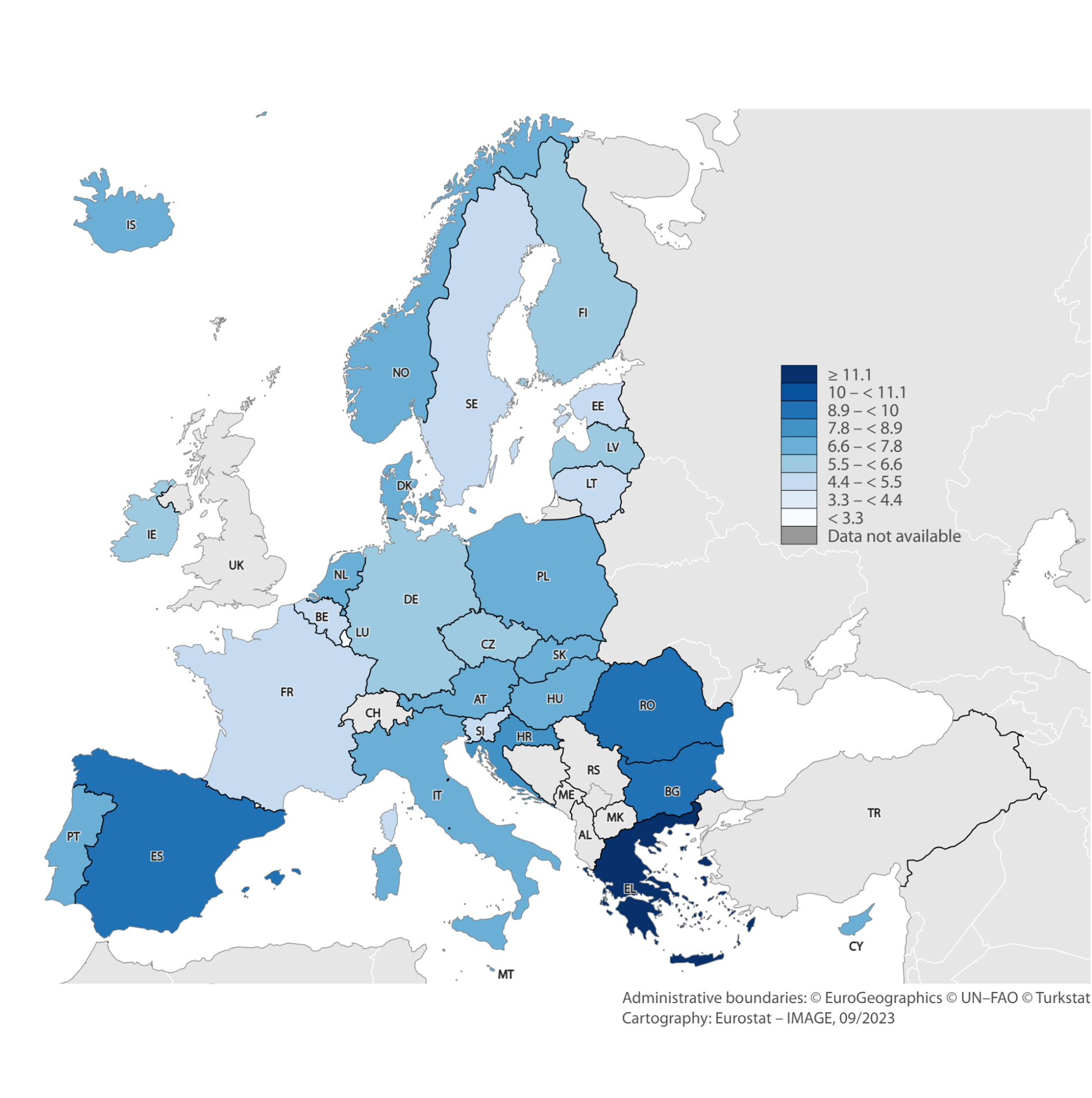 Source: European Labour Force Survey. Microdata. Own calculations.
Source: European Labour Force Survey. Microdata. Own calculations.
Note: Data for CY, EE, IS, LV and LU have lower reliability because of the small sample size. LFS data for MT are not available.
The workforce is composed mainly of women (65 per cent in 2021). Unlike most other occupations, sales workers are not ageing significantly, with less than 30 per cent of the workforce being 50 years or older (Figure 6).
Figure 6: Sales workforce by age (in %)
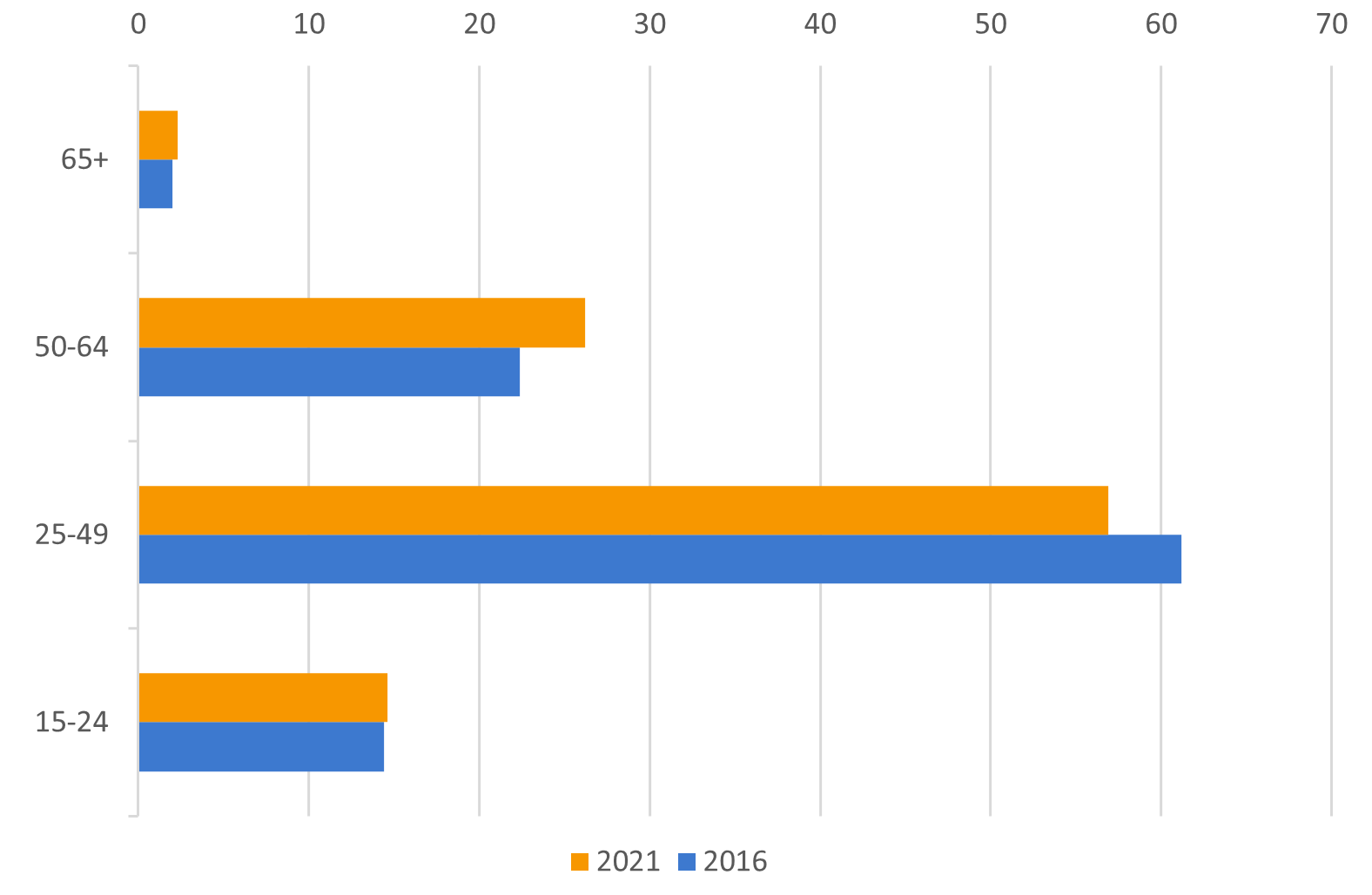 Source: European Labour Force Survey. Microdata. Own calculations.
Source: European Labour Force Survey. Microdata. Own calculations.
The share of sales workers reporting part-time or temporary employment is relatively larger than the one across all occupations (see Figure 7).
Figure 7: Contract and hiring trends for sales workers (in %)
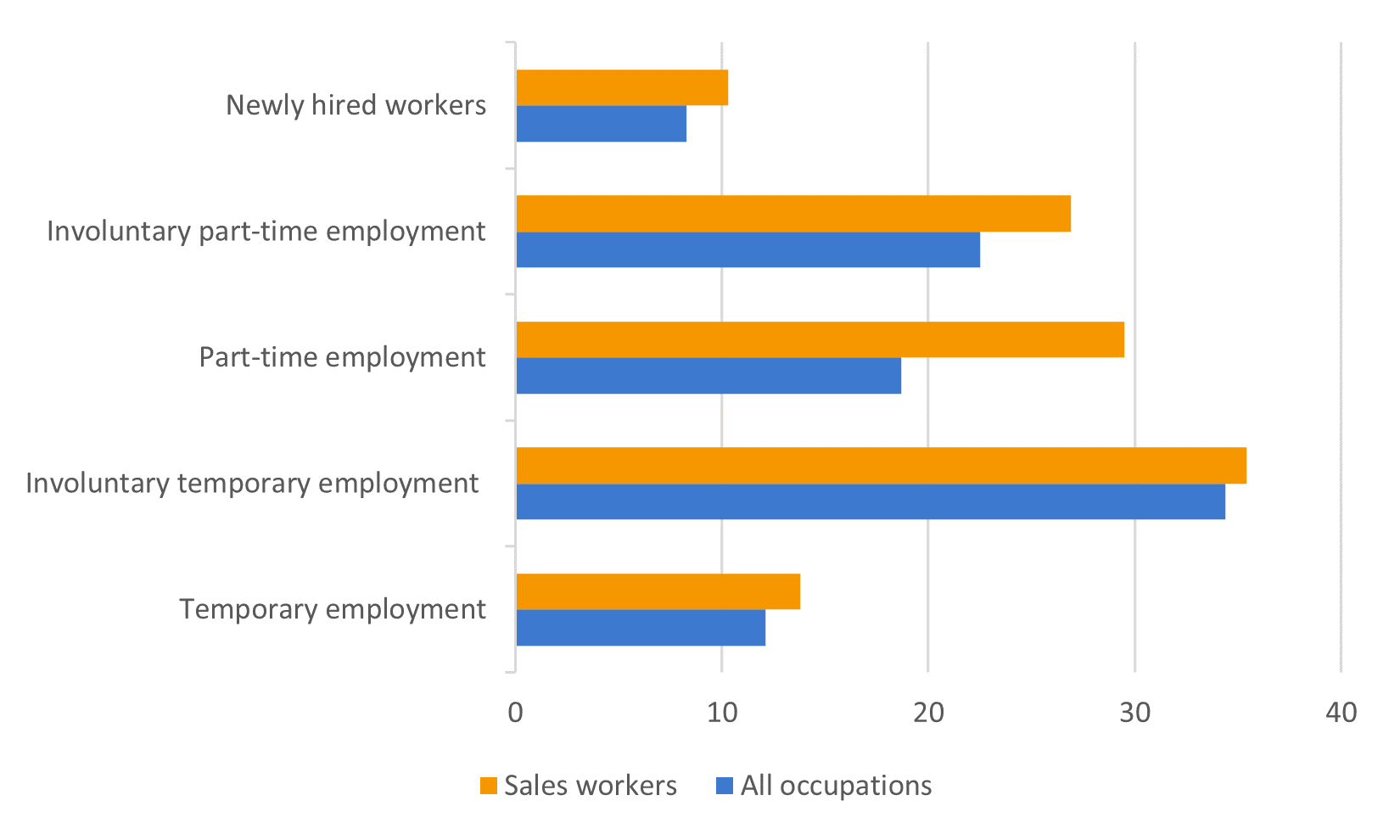 Source: European Labour Force Survey. Microdata. Own calculations.
Source: European Labour Force Survey. Microdata. Own calculations.
Skill needs and future trends
Sales workers ‘ skill needs mainly focus on interpersonal skills and manual tasks, as they deal with clients, assist, and sell items while also coping with lifting heavy objects. Digital tasks and skills are of some significance, but at lower levels compared to all occupations average. Training needs tend to be more about the overall skills upgrade than specifically on the digital ones. People report of fairing to lose their jobs and less work satisfaction to all occupations average.
Figure 8: Skills, training needs and job perception of sales workers (in %)
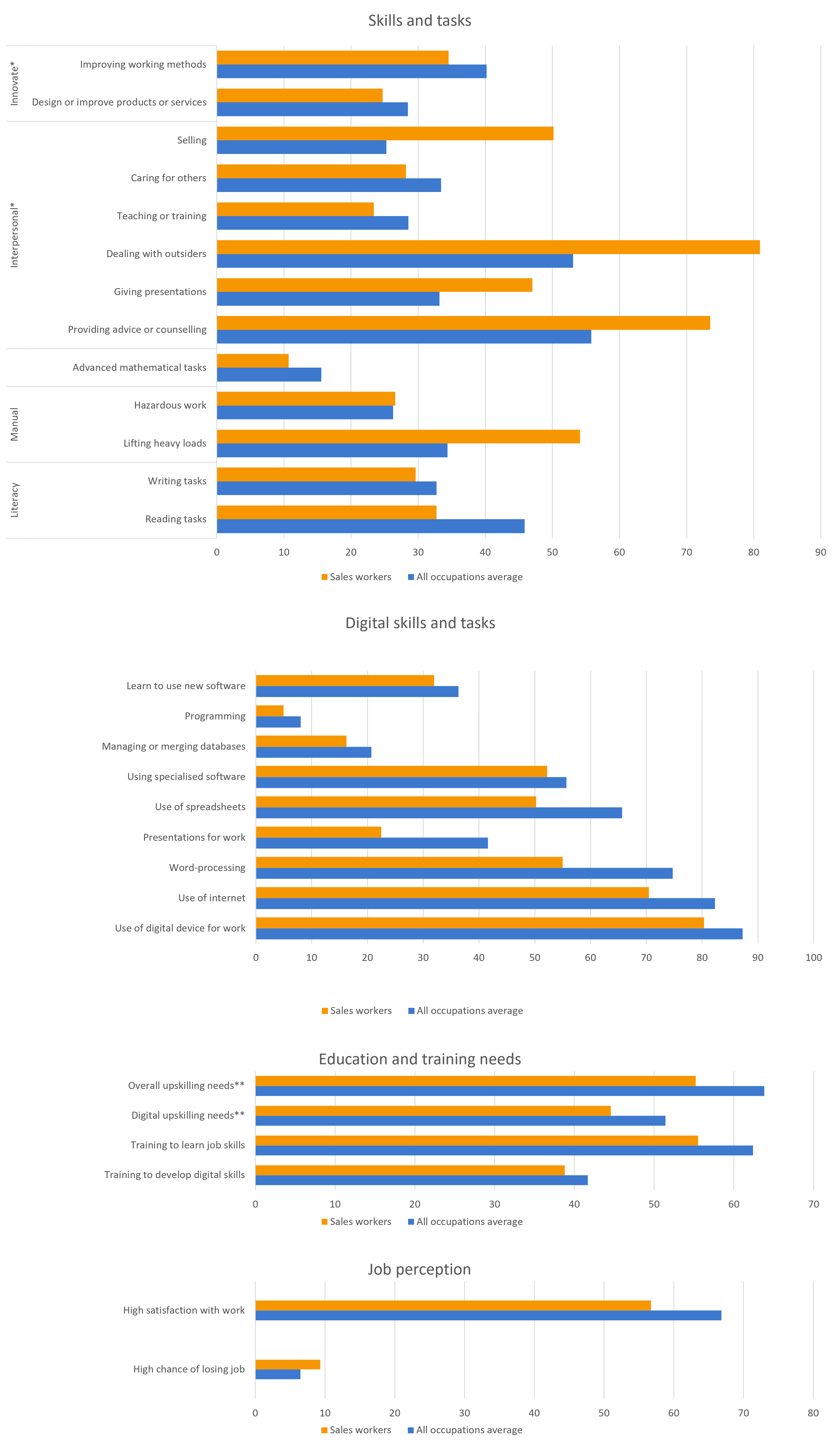
Source: European Skills and Jobs Survey Microdata. Own calculations.
Unless stated otherwise, it is a share of people reporting that a task/skill is part of their job.
*Always or often
** Share of workers reporting these needs to a great or moderate extent.
Cedefop’s Skills forecast provides a detailed view of the future demand for sales workers. Overall, employment for sales workers is expected to slightly decline over the period 2022 to 2035. This means that, compared to 2022, there will be about 546 thousand less sales worker jobs.
Future employment growth will vary by country. Figure 9 compares the employment growth experienced over the relatively recent past to that projected to take place in the future. Employment in four countries grew in the past decade and it is forecast to do so in the next decade as well. Spain and Romania are among those with the highest past and expected future growths, while especially Estonia and Lithuania represent the opposite trend.
Figure 9: Past and expected future employment trend of sale workers
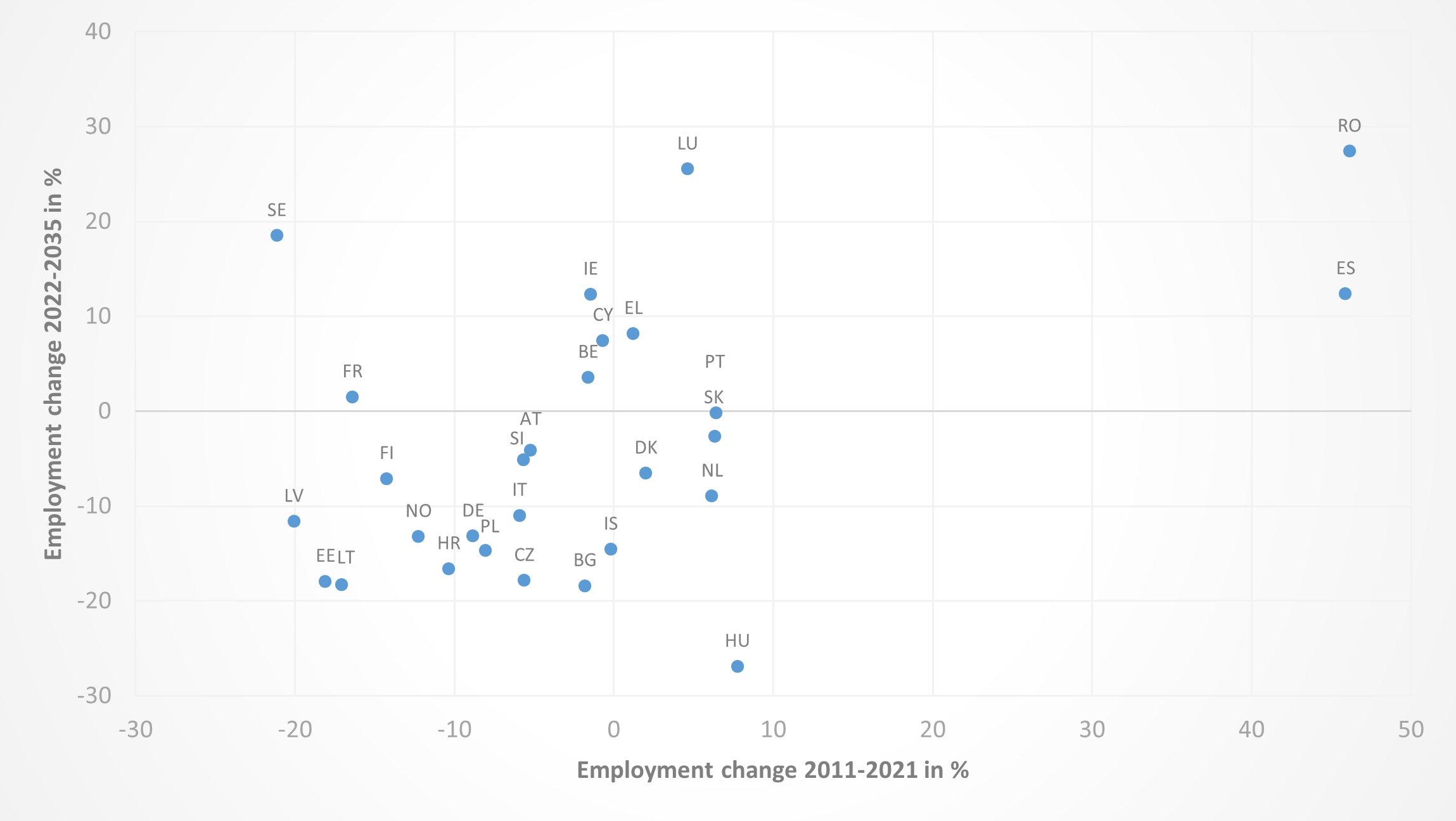 Source: European Labour Force Survey. Microdata. Cedefop Skills Forecast. Note: Data for CY, EE, IS, LV and LU have lower reliability because of the small sample size. LFS data for MT are not available.
Source: European Labour Force Survey. Microdata. Cedefop Skills Forecast. Note: Data for CY, EE, IS, LV and LU have lower reliability because of the small sample size. LFS data for MT are not available.
New job creation or destruction is, however, not the main driver behind job demand. Most job openings are a result of people leaving them for other opportunities, or those leaving the labour market completely (retirements; parent leave, etc.). This replacement demand is frequently much more substantial, being estimated at 6.8 million. It is, in fact far higher than the projected job loss (Figure 10).
Overall, when future job loss is added to the replacement demand, an estimated 6.2 million job openings for sales workers will need to be filled between 2022 and 2035.
Figure 10: Future job openings for sales workers (000s)
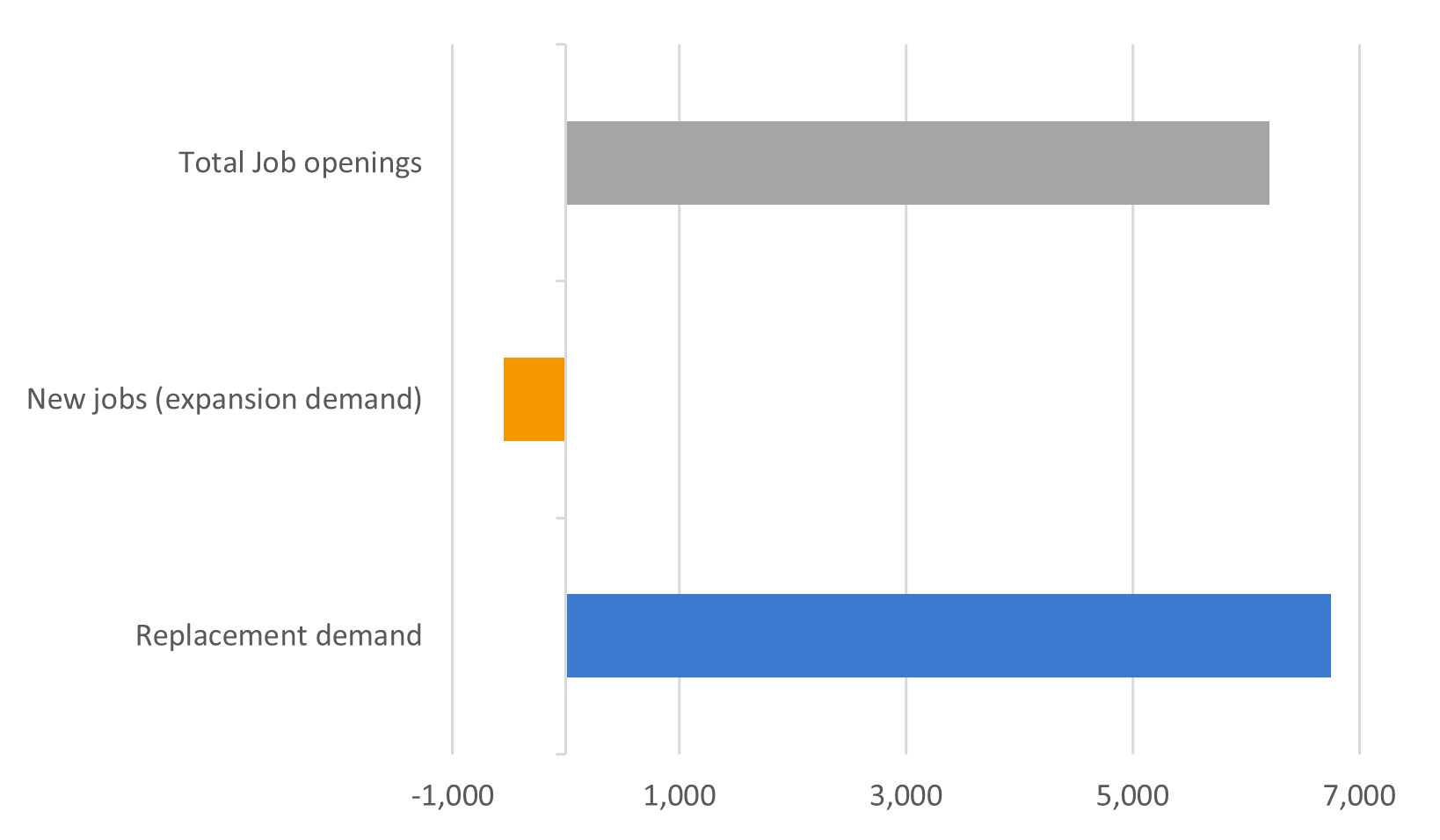 Source: Future job openings indicator based on the Cedefop Skills Forecast. Own calculations.
Source: Future job openings indicator based on the Cedefop Skills Forecast. Own calculations.
More than 60 per cent of sales workers held medium-level qualifications in 2021 (i.e. at ISCED levels 3 or 4). This is not projected to change much by 2035. The share of workers with low levels of qualification (ISCED level 2 or lower) is projected to fall from 20 per cent in 2022 to 12 per cent in 2035, while the share of highly qualified workers (i.e. those qualified at ISCED level 5 and over) is projected to increase from 17 per cent to 26 per cent over the same period.
Looking forward
Digitalisation has been changing the sales landscape for some time and the recent pandemic speeded this process up. Sustainability requirements affect the daily work of salespeople. Both drivers also modify the existing stock of products and services to be sold and introduce new ones. Cedefop projections forecast a decline of 4 per cent in sales employment by 2030. Sales workers who can adapt to these changes and develop new skills will be well-positioned to succeed in this landscape. The majority of sales workers (81 per cent, see the discussion above) are occupied in the wholesale & retail trade sector. Developments in this sector will affect the future skillsets of sales workers.
- Technological change reduces the number of salespeople needed in the stores of the future and forces those remaining to use technology to complement their daily tasks. Technologies such as automated cashier machines reduce the need for physical store workers and create the need for new skills in handling technology and facilitating customers into using it. The use of data and analytics can assist the sales workforce in providing insights into customers’ needs and behaviour with the help of machine learning that mines behavioural data from sales and marketing (Smith et al, 2020). As sales workers are continuously working with larger sets and better-analysed data, they will increasingly continue to use tools like personalised digital assistants, which send real-time sales data to workers. Such smart devices and tablets will continue to gradually enhance the planning, management and customer attention tasks (Lopez et al, 2021). Currently, evidence shows that the skills development of sales workers in retail is not keeping up with the pace of such changes (Simon et al, 2020).
- Artificial intelligence (AI) is often the driving force behind the rapid developments in retail (such as personalisation and recommendation systems, sales/customer relationship management, supply chain optimisation, inventory management and store task creation, Shankar et al, 2020). Retailers aim to be better equipped to cater to the more predictable customer demand as well as to the complementary aspects of the merger of e-commerce and physical retail by integrating AI, computer vision and IoT in every part of the shopping experience (Knox, 2022). As sales are fundamentally changing towards a more personalised approach, the soft skills of sales workers (communication, language, problem-solving) will become more sought after. Augmented Reality (AR) technology can be utilised in helping salespeople in retail to visualise the store or shelve set-up before implementing it. AR-enabled enterprise devices can display a 3D planogram on the sales floor to serve as a guide for the setup process while combining AR with other AI-based object detection technologies used by manufacturing industries, workers can spot out-of-place products, improperly zoned items, and even damaged products.
- The rise in online sales has resulted in more connected, less loyal, more informed, and channel-agnostic consumers, while e-retailers capture a large share of online sales and online marketplaces have become dominant platforms (McKinsey, 2022). These developments increase the pressure on physical retailers to expand their online presence. Innovations bridging online and offline shopping such as “buy online pick up in store” (BOPIS) services have the potential to affect both the number of workers in future retail stores and their everyday tasks.
- Increased concerns for sustainability and the ambition of achieving climate neutrality in Europe is bound to impact the retail sector in many ways as it shifts its focus towards more sustainable and environmentally friendly products and services. Consumer demand for sustainable goods is growing, particularly among younger customer groups (Deloitte, 2023) and for cosmetics, pharmaceutical, fashion and food products (EIU, 2021). Sustainability-oriented retailers go beyond mere profit making to include social and environmental considerations into knowledge about their product range and its productions. They can also promote reuse and recycling in the supply chain (Vadakkepatt et al, 2020). Sales workers need to adjust to the demand for sustainable products by receiving training for sustainability principles and understanding the frameworks that set the conditions for sustainable products and services, such as the Circular Economy Action Plan (2020) and the circular economy strategy, as well as about their own company’s external actions to promote sustainability. This will enable them to communicate and inform customers about which products are eco-friendly and how do they compare with other products and/or services offered by competitors.
- The Covid-19 pandemic has further accelerated the turn towards sustainable products (McKinsey & Company, 2021) and the digital transition in sales. This is reflected in the spread of new and familiar digital tools and the increased shift from physical to online stores, which has put sales jobs at risk (McKinsey & Company, 2020).
Equipping sales workers with updated and new skills is important for keeping them afloat in a rapidly digitalising and greening retail sector. Most sales workers enter the workforce with vocational qualifications at ISCED levels 3 and 4. According to Cedefop, in 2019 and 2020, 63 per cent of sales workers aged 15-34 reported possession of a vocational qualification. This prompts changes in both initial vocational education and training (IVET), continuing vocational education and training (CVET) schemes, and programmes (such as apprenticeships) so that new workers are adequately trained, and existing workers are reskilled and upskilled to avoid skills obsolescence.
The stakeholders in the retail ecosystem have outlined the challenges to be addressed, such as the future of physical stores combining ‘high tech and high touch’, omnichannel selling (combining physical and online facilities). These need skills like interpersonal awareness (customer centricity), data analytics and literacy, and a combination of other digital and sustainable skills.
In terms of Initial Vocational Education and Training, apprenticeships can be an effective means to equip young sales workers with the necessary skills to work in retail stores. There is now much evidence demonstrating the effectiveness with which apprenticeships can equip people with the skills required by the labour market (cf. Cedefop’s research on the effective delivery of apprenticeships). However, apprenticeships in the retail sectors appear to be among those with the lowest quality (Cedefop et al., 2021, based on a study conducted in by the German Trade Union Confederation). Most firms in this sector are SMEs or micro firms that cannot afford a high-quality learning environment.
The European Alliance for Apprenticeships provides support to countries and sectors looking to improve and expand the provision of apprenticeships, including also in the retail sector. In late November 2022, under the Commission’s support, retail employers and trade union associations Eurocommerce and Uni Europa initiated a large-scale skills partnership for the retail industrial ecosystem, which aims to enable workers and businesses to acquire skills necessary for the digital and green transitions.
Sales apprenticeships are also included among the 30 new apprenticeship programmes introduced recently in Ireland (Cedefop et al., 2021). These programmes span both further and higher education and are led by consortia made up of industry and education stakeholders working in partnership.
As regards continuing education, the development of tailored programmes addressing the skill needs of workers in sales or in the retail sector is supported by EU funds through the Erasmus+ programme. For example, the ongoing Talk Retail Erasmus+ project connects partners from Spain, Italy, France, UK and Latvia to develop communication and language skills in the context of an increasingly internationalising business landscape. Throughout the project lifetime, the partners are developing a set of online courses for enhancing interpersonal communication and English skills with the aim of increasing awareness of the importance of transversal skills as well as lifelong learning opportunities for sales workers.
Another example of good practice is the recent Erasmus+ RETAIL project developed innovative training and practical education and innovative training courses related to sustainable business models in the retail sector. It was directed, among others, to young and unemployed people, for whom the retail sector is usually an entry point into the labour market. The youth and unemployed training package created within the project is available online. In addition, the ongoing digiskill-retail project, which aims to support the uptake of digital competences and skills of trainees and employees in the retail sector using modern retail-specific e-learning units, as well as support the upskilling of teachers and trainers in these competences. The project studies the existing qualification deficits regarding digital competences among vocational trainers, lecturers, and vocational teachers in the retail sector, develops between multiple practice-relevant microlearning units for vocational training targeting deficits in information and data competence, communication and cooperation, safety, analysis and reflection, and construct additional training units tailored for training vocational teachers.
How to cite this publication:
Cedefop (2023). Sales workers: skills opportunities and challenges. Skills intelligence data insight.
Further reading
Beręsewicz, M. and Pater, R. (2021). Inferring job vacancies from online job advertisements, Luxembourg: Publications Office, 2021. https://ec.europa.eu/eurostat/web/products-statistical-working-papers/-/ks-tc-20-008
Cedefop et al. (2021). Apprenticeship governance and in-company training: where labour market and education meet: Cedefop community of apprenticeship experts: short papers. Luxembourg: Publications Office of the European Union. Cedefop working paper; No 3. http://data.europa.eu/doi/10.2801/065622.
Deloitte (2023). ‘Sustainability in retail’, What we do: Industries: Consumer, article
Economist Intelligence Unit (EIU) (2021). ‘An Eco-wakening: Measuring global awareness, engagement and action for nature’, The Economist & World Wildlife Fund, published 17 May 2021
European Commission (2022). ‘European skills: Launch of a large-scale partnership on skills in retail’, DG Employment, Social Affairs & Inclusion, news, published 29 November 2022
Knox, T. (2022). ‘Three technology Trends Transforming The Retail Industry’, in Forbes Tech Council, article, published 25 January 2022
Lopez, T., Riedler, T., Kohnen, H., Futterer, M. (2021). ‘Digital value chain restructuring and labour process transformations in the fast-fashion sector: evidence from the value chains of Zara and H&M’, in Global Networks, Vol. 22(4), pp. 684-700
McKinsey & Company (2020). ‘Adapting to the next normal in retail: The customer experience imperative’, in McKinsey & Company: Retail, article, published 14 May 2020
McKinsey & Company (2021). ‘NEF Spotlight: The path forward for retail’s sustainable future’, McKinsey & Company: Strategy and Corporate Finance
McKinsey & Company (2022). ‘The tech transformation imperative in retail’. McKinsey & Company: Retail, article, published 20 May 2022
Napierala, J.; Kvetan, V. and Branka, J. (2022). Assessing the representativeness of online job advertisements. Luxembourg: Publications Office. Cedefop working paper, No 17. http://data.europa.eu/doi/10.2801/807500
Shankar, V., Kalyanam, K., Setia, P., Golmohammadi, A., Tirunillai, S., Douglass, T., Hennessey, J., Bull, J.S., Waddoups, R. (2021). ‘How Technology is Changing Retail’, in Journal of Retailing, Vol. 97(1), pp. 13-27
Simon, P., Tufft, C., Zampella, P. (2020). ‘Closing the skills gap in retail with people analytics’. McKinsey & Company: Retail, article, published 28 August 2020
Smith, A.-S., Stober, J., Ulrich, J. (2020). ‘How data analytics helps sales reps win more deals’, McKinsey & Company: Growth, Marketing & Sales, article, published 4 November 2020
Vadakkepatt, G.G., Winterich, K. P., Mittal, V., Zinn, W., Beitelspacher, L., Aloysiuis, J., Ginger, J., Reilman, J. (2020). ‘Sustainable Retailing’, in Journal of Retailing, Vol. 97(1), pp. 62-80
Data insights details
Table of contents
Page 1
SummaryPage 2
Employment and job demandPage 3
Skill needs and future trendsPage 4
Looking forwardPage 5
Further reading
